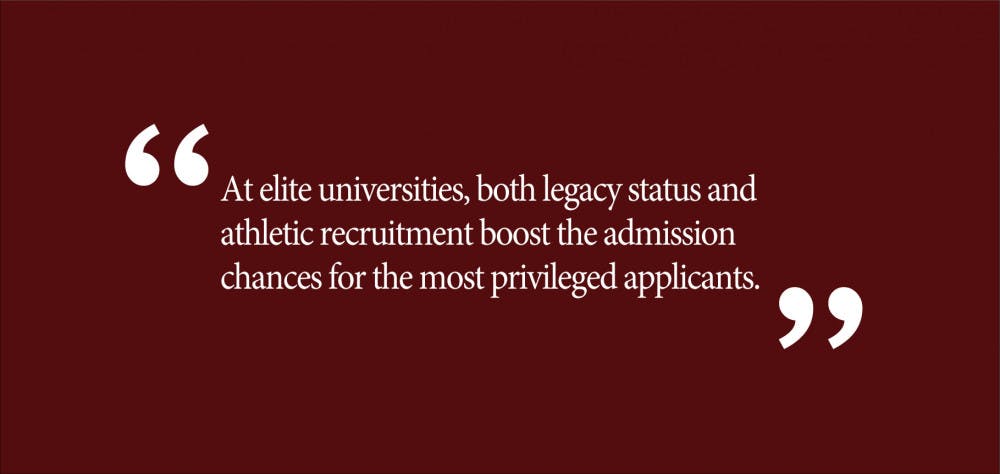On Oct. 1, a federal court upheld Harvard’s race conscious admission practice. During the case, Harvard was forced to publish admission data from 2009 to 2014, offering an unprecedented inside look at the college admission process at an elite American university. In September, three economics professors — Peter Arcidiacono, Josh Kinsler and Tyler Ransom — published a study analyzing this data. The results are striking: Admitted legacy applicants and recruited athletes were overwhelmingly wealthy and white.
To combat widening income inequality and declining social mobility, Ivy League universities must take action: It’s time to end legacy admission and athletic involvement in the admission process.
Arcidiacono et al. found a strong advantage for applicants with “legacy status” and recruited athletes: Legacy applicants were 5.7 times more likely to be admitted, and recruited athletes were 14 times more likely to be admitted. Nearly 70 percent of legacy and recruited athlete applicants who were admitted to Harvard during the studied period were white. Additionally, for the class of 2019, 40.7 percent of legacy students and 26 percent of recruited athletes came from families earning more than $500,000 a year, compared to 15.4 percent of the class as a whole.
Ultimately, if Harvard did not consider legacy status, it would theoretically decrease the number of white admitted students by 4 percent and raise the number of admits from other racial groups by 4 to 5 percent each. Similarly, if Harvard stopped recruiting athletes, the proportion of white admits could decrease by 6 percent, while the number of Hispanic and Asian American admits would rise 7 and 9 percent respectively; African American admits would remain unchanged.
There is evidence that these admission practices operate similarly at other elite universities, including Brown. In 2002, James Schulman and former Princeton President William Bowen studied admission at 30 selective colleges and found that “athletes were given a 48 percent boost in admissions, compared with 25 percent for legacies and 18 percent for racial minorities.” Additionally, the demographics of athletes at Harvard and the rest of the Ivy League are similar — 65 percent of Ivy League athletes are white.
These statistics paint a clear picture: at elite universities, Both legacy status and athletic recruitment boost the admission chances for the most privileged applicants.
While ending legacy admission and athletic recruitment are both important, legacy admission practices have garnered more attention: There are numerous opinion pieces in The Herald, the Daily Pennsylvanian, the Harvard Crimson, the Yale Daily News and other college newspapers criticizing the practice. Thus, I will focus the rest of my argument on why ending athletic recruitment is necessary.
Like legacy admission, athletic recruitment disproportionately favors wealthy and white children. Increasingly, athletic success requires a lot of cash. According to the Aspen Institute, the average family spends $2,292 annually on sports. This cost is one reason why children from low-income families are half as likely to play sports as children from families that make $100,000 or more a year. Like legacy admission, athletic recruitment amplifies existing inequalities.
According to the Ivy League website, “Coaches may communicate to the Admissions Office their support for candidates who are athletic recruits.” As a result, athletic recruits are highly likely— though not guaranteed— to be admitted. For example, athletic recruits with scores of 1 or 2 on Harvard’s scale of 1 to 6 have an acceptance rate of 86 percent, compared to 16 percent for other applicants with similar scores. Athletes with scores of 4 have a 70 percent acceptance rate, compared to .076 percent for non-athletes applicants with the same score.
To make the admission process more equitable, coaches should not be able to communicate with admission offices. This isn’t to say that athletics shouldn’t be considered at all during the application process. Playing a sport teaches teamwork and discipline. Athletes must manage their time carefully to balance athletics and schoolwork. These skills are valuable and should be considered by admission officers — just during the regular admission process and without the influence of coaches.
Some may be concerned that if coaches cannot help athletes gain admission, talented athletes may choose to go elsewhere. This may happen. But being good at sports should not supersede combating inequality.
Others may argue that successful teams are important because they help colleges raise funds. While there is some research that indicates a positive relationship between donations and athletic success, much of these donations go to athletics directly, and may even “crowd out” academic funding.
The Ivy League already holds its schools to stricter standards than the NCAA. For example, Ivy league schools cannot give athletic scholarships. It is feasible that the Ivy league could prohibit its coaches from communicating with admission offices.
Ultimately, when five of the eight Ivy League schools have more students from the top 1 percent of the income distribution than the bottom 60 percent, it’s clear that it’s time to end all unfair admission practices.
Rebecca Aman ’20 can be reached at rebecca_aman@brown.edu. Please send responses to this opinion to letters@browndailyherald.com and op-eds to opinions@browndailyherald.com.





